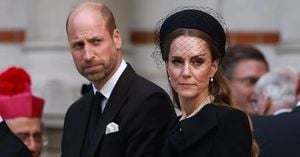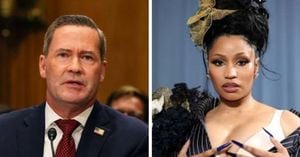In a move that has sent ripples through the global security community, former President Donald Trump announced on October 29, 2025, that the United States would share sensitive nuclear submarine propulsion technologies with South Korea. The revelation, made via a post on Truth Social, marks a significant diplomatic and technological departure from previous U.S. policy, which had long withheld such technology from even its closest allies, save for the United Kingdom and, more recently, Australia under the AUKUS agreement.
Trump, currently on a diplomatic tour of Asia, declared, "South Korea will be building its Nuclear Powered Submarine in the Philadelphia Shipyards, right here in the good ol’ U.S.A. Shipbuilding in our Country will soon be making a BIG COMEBACK." According to Breaking Defense, this statement underscores a dramatic shift in the U.S. approach to Indo-Pacific alliances and industrial cooperation, signaling a new era in both defense strategy and shipbuilding.
The announcement comes on the heels of South Korea's Hanwha Group acquiring the Philly Shipyard from a Norwegian investment group in 2024. The purchase was a calculated move to deepen Hanwha’s ties with the U.S. Navy and to position itself as a key player in American naval construction. While Philly Shipyard has historically focused on commercial vessels, Hanwha’s leadership has made no secret of its ambitions to pivot toward military contracts, especially in the lucrative and strategically vital submarine sector.
But this is no small undertaking. As Breaking Defense reports, building nuclear submarines is a massive, complex endeavor—one that even Australia, backed by the AUKUS partnership, expects will stretch well into the 2030s and 2040s. For Hanwha and Philly Shipyard, the transition from commercial to nuclear military shipbuilding will demand not only vast capital investment but also the recruitment and training of a highly specialized workforce. The U.S. Navy itself has been waging a years-long campaign to bolster its maritime industrial base, struggling with high attrition rates and fierce competition for skilled labor.
Trump’s social media posts didn’t stop at technology transfers. In a separate statement, he claimed that South Korea had agreed to pay $350 billion in exchange for lower tariffs imposed by the White House. While the specifics of this deal remain unclear, the eye-popping figure suggests a broader economic dimension to the burgeoning U.S.-South Korea defense partnership. According to the Associated Press, the arrangement is part of a strategic effort to balance trade relationships while deepening military cooperation.
South Korean President Lee Jae Myung, who met with Trump at the Gyeongju National Museum in South Korea on October 29, 2025, provided clarification on his government’s intentions. According to Bloomberg, Lee said that South Korea’s request had been for access to nuclear fuel technology, not for nuclear weapons—a distinction that had apparently been misunderstood by the previous U.S. administration. Lee emphasized that possessing nuclear-powered submarines would enable South Korea to contribute more substantially to regional security, echoing arguments made by American and British officials when justifying their support for Australia’s nuclear submarine ambitions.
The timing of the announcement is notable. On October 28, 2025, President Lee formally requested U.S. approval for South Korea to build a nuclear-powered submarine at an American shipyard. Trump’s swift approval the following day signals both a willingness to accommodate key allies and a desire to strengthen the U.S. industrial base. Lee stated that the submarine would help track North Korean and Chinese vessels and would ease the burden on U.S. forces in the region. However, Lee’s office later clarified that his reference was to vessels operating in waters near North Korea and China, rather than singling out those countries directly. This nuance reflects the delicate balance Seoul must strike between bolstering its own security and avoiding unnecessary provocation in an already tense neighborhood.
The strategic logic behind South Korea’s pursuit of nuclear-powered submarines is clear. As regional threats evolve and North Korea continues to develop its own submarine-launched ballistic missile capabilities, Seoul is eager to enhance its deterrence posture. Nuclear-powered submarines offer distinct advantages: they can remain submerged far longer than their conventional counterparts, travel greater distances, and operate with a level of stealth and endurance that is critical for modern naval operations. By building these vessels in the United States, South Korea not only gains access to cutting-edge technology but also strengthens its alliance with Washington at a time when the Indo-Pacific is becoming the focal point of global security competition.
Yet, this partnership is not without its challenges. Transforming Philly Shipyard into a facility capable of constructing nuclear submarines will require overcoming significant logistical, regulatory, and workforce hurdles. The U.S. Navy’s ongoing struggle to attract and retain skilled workers for its own submarine programs suggests that Hanwha will face similar obstacles. According to Breaking Defense, the Navy has launched an extensive marketing campaign to recruit maritime workers, but attrition remains high and fiscal targets are proving elusive.
There are also broader questions about the implications of this technology transfer. The nuclear propulsion technology used by the United States, United Kingdom, and Australia is among the most closely guarded secrets in the defense world. Granting South Korea access to this technology represents a significant leap of trust—and a calculated risk. Historically, the U.S. has been reluctant to share such sensitive capabilities, fearing proliferation and the potential for regional arms races. However, the changing strategic landscape and the rise of new threats have prompted a reassessment of these longstanding policies.
For South Korea, the acquisition of nuclear-powered submarines is not just about military hardware—it’s about asserting a larger role in regional security. Lee Jae Myung’s comments reflect a desire to shoulder more responsibility within the alliance, reducing the operational burden on U.S. forces while enhancing South Korea’s ability to monitor and respond to threats in its own backyard. This move is likely to be watched closely by both allies and adversaries in the region, particularly as tensions with North Korea and concerns over Chinese maritime ambitions continue to simmer.
As the dust settles on this historic announcement, the world will be watching to see how the U.S. and South Korea navigate the technical, political, and strategic challenges ahead. The success—or failure—of this ambitious partnership could reshape the balance of power in the Indo-Pacific for decades to come.




